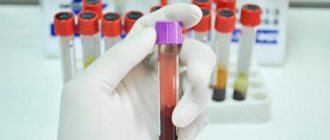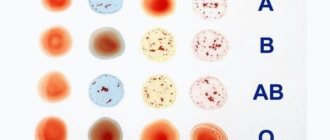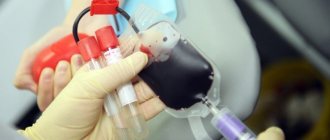Every person should know their blood pH. Acidification of the blood leads to illness and poor health. Severe alkalization - loose skin, dry and brittle hair, nails.
Every liquid has its own level of acid-base balance, including human blood. If there is a disorder in the functioning of the body or a malfunction of a specific system or organ, a PH blood test is done.
- The term blood pH is the level of hydrogen content in the body and general acidity. If the balance of alkalis is maintained, then all systems and organs function normally.
- The acid-base balance is in a normal state if the liver, lungs and kidneys function well and harmoniously. These are real “compensators” that remove harmful substances from the body.
- Therefore, every person should monitor their blood PH level to prevent the development of serious diseases.
Blood PH level of a healthy person: normal
PH level of the blood of a healthy person: normal
The level of alkaline indicator in the blood is the basis for doctors to prescribe treatment if they have large deviations from the norm. Thanks to these indicators, it is possible to monitor the condition of the body, and if malfunctions occur in the functioning of organs or systems, such an analysis should be done.
The normal PH level of the blood of a healthy person is no less than 7.35 and no higher than 7.45. All indicators that differ from the norm to a lesser or greater extent are deviations that are incompatible with life and require urgent medical intervention.
Summary
The pH level of your blood indicates how acidic it is.
The typical pH of blood in the arteries is 7.35-7.45. A complex set of mechanisms and feedback loops help regulate blood pH and maintain normal body function.
When blood pH changes, it may indicate an underlying health problem that needs to be addressed. Your doctor can use arterial blood gas and electrolyte tests to determine when this occurs and make appropriate treatment recommendations.
Blood pH level during acidosis
Blood PH level during acidosis
If the acidity in the body is normal, then the PH readings will be at the level of 7.4 units. If this indicator decreases significantly, a diagnosis of “acidosis” is made. The pH level of the blood during acidosis is 7.0 or less.
Mild acidosis does not manifest itself in any way. But, if the indicators decrease to critical limits, which can only be recorded in laboratory conditions, then the person experiences the following symptoms:
- lack of oxygen;
- a feeling of shock at the primary stage of many diseases - diabetes and others;
- nausea;
- vomiting or urge to vomit;
- breathing problems.
Acidification of the body occurs for the following main reasons:
- nervous tension;
- obesity;
- against the background of cardiovascular diseases;
- when eating sweet and meat foods in large quantities.
When a severe form of acidosis is detected, it is necessary to establish the causes of this disease. You should definitely consult a doctor who will correctly prescribe treatment, diet and tell you about all the consequences if you do not control your blood PH level.
Blood pH level in alkalosis
Blood PH level during alkalosis
Alkalosis, unlike acidosis, appears immediately as soon as the blood PH readings become above 7.45. When the body becomes strongly alkalized, the skin becomes flabby and dry. A person takes on the ugly appearance of a “dried wooden knot.”
The blood pH level during alkalosis is normalized if the causes that caused this deviation are eliminated. The treatment process can begin with breathing exercises. This will help saturate the blood with carbon dioxide and oxygen compounds in the correct proportion. Read more about acidification and alkalization of the body in this article.
Important: Do not self-medicate! It may be dangerous. Never make even rough diagnoses for yourself or your loved ones.
Diseases that lead to acidosis and alkalosis
Disturbances in acid-base balance can occur in any severe pathological process. Ischemia, hypoxia, inflammation or tissue destruction, metabolic disorders cause overstrain of the body's compensatory systems, they cease to cope with overloads. Depending on the form of acidosis or alkalosis, patients require different approaches to therapy.
Non-gas acidosis
The most severe and common form of blood acidity disorder. It develops with oxygen deficiency of any origin. The causes of metabolic disorders can also be:
- congenital disorders of enzyme activity (enzymepathies);
- physical stress;
- diabetes;
- prolonged fasting, diet with excess animal protein;
- any prolonged or severe inflammation;
- liver diseases;
- tumors;
- alcoholism;
- drugs to lower blood sugar, antiviral drugs, non-steroidal anti-inflammatory drugs, Diacarb, potassium salts;
- intestinal obstruction, vomiting, diarrhea;
- poisoning with acetic acid, methanol, alcohol surrogates;
- fistula in the intestines, gallbladder duct or pancreas (leads to loss of alkaline intestinal juice);
- kidney disease, especially glomerulonephritis, renal failure.
Moderate acidosis occurs with reduced blood pressure in the venous and arterial vessels, low venous return of blood to the heart, and a decrease in cardiac output.
When the body is severely acidified, the blood vessels narrow. Sodium is intensively excreted in the urine, while potassium increases in the blood, and its content in skeletal muscles and myocardium decreases. This leads to disturbances in excitability and conduction, extrasystoles, tachycardia, and ventricular fibrillation.
Brain nutrition is sharply reduced due to narrowing of the cerebral arteries, low blood pressure, and weak cardiac output. Patients often experience impaired consciousness, microcirculatory disorders and thrombosis. Breathing becomes deep and its frequency increases. Urine output decreases.
For lactic acidosis (accumulation of lactic acid), the administration of sodium bicarbonate is indicated, and for an excess of ketone bodies (ketoacidosis in diabetes), treatment begins with the administration of insulin in saline solution. In alcoholic ketoacidosis, an intensive supply of 5% glucose into the venous network is required to suppress the formation of ketone bodies in the liver.
Watch the video about the blood PH level and its effect on the body:
Gas acidosis
Occurs in chronic lung diseases (pneumonia, asthma, fibrosis, autoimmune lesions), swelling of the lung tissue, accumulation of fluid, blood, or air entering the chest. The respiratory form of acidosis also occurs with:
- oppression of the respiratory center by drugs, due to injury, swelling of brain tissue or inflammation;
- blockage of the trachea or bronchi by a foreign body or during spasm;
- severe cardiopulmonary failure;
- inhaling air with a high carbon dioxide content;
- diaphragmatic paralysis, poliomyelitis, myasthenia gravis, or administration of muscle relaxants.
All these processes increase the CO2 content in the blood, leading to oxygen starvation - hypoxia. Since the respiratory organs cannot compensate for acidosis, the main burden falls on the kidneys - they remove acids and retain bases. The severity of the condition is associated with the addition of metabolic disorders, depression of the heart, and increased pressure inside the skull.
In severe cases, gas alkalosis leads to coma. For treatment, oxygen therapy is prescribed by inhalation or connection to a ventilator.
Non-gas alkalosis
It happens with the loss of a large amount of gastric juice (for example, toxicosis of pregnant women with uncontrollable vomiting), intestinal obstruction, food poisoning, excessive intake of alkaline mineral waters or intravenous administration of soda solutions. In children, the cause may be whooping cough, narrowing of the gastric outlet (pyloric stenosis).
Drug alkalosis is caused by hormonal therapy with steroid drugs, taking Hypothiazide.
Manifestations are associated with dehydration, as sodium is lost through the kidneys and carries water with it. This disrupts the functioning of the heart, central and peripheral nervous systems. For treatment, a solution of sodium chloride and potassium is used intravenously under the control of ion levels in the blood.
Blood pH level in cancer: comparison
Blood PH level in cancer: comparison
A person's blood PH level fluctuates throughout life. But there are critical indicators when chronic diseases and even cancer can occur. It is bad for the human body when the body is highly acidified, that is, PH values are below 7.45 units, and when a sharp alkalization occurs. If the indicator is below 6.0 units, then the alarm should be sounded.
Blood pH level in cancer is below 6.0. With such indicators, a person has a poor complexion, pale lips, no blush, hair and nails break. We can say that a person has a sick appearance.
Remember: Only a doctor should make a diagnosis! Don't do anything on your own. If you have any doubts about your health, get examined and take the necessary tests. You can only sound the alarm in a timely manner if you feel unwell or other symptoms that interfere with your normal life.
Only a doctor should compare blood pH levels in cancer. He will be able to correctly prescribe treatment and take emergency measures that will be a salvation for your health.
Blood pH: normal and abnormalities
The acidity and alkalinity of human blood is assessed on a pH scale of 0-14 (strongly acidic - strongly alkaline). A neutral pH level is 7.0 (corresponding to distilled water), which is in the middle of this scale.
Blood is usually slightly alkaline, its normal value falls within a certain range of 7.35–7.45. Interestingly, the pH of human blood is normally different for venous and arterial blood:
- venous – 7.32-7.42;
- arterial – 7.37-7.45.
Only at such values do the systems work harmoniously, removing excess hydrogen and bases. When the values on the scale shift to the right of the permissible interval, alkalosis develops, and to the left, acidosis develops.
The body tries to keep the blood pH within 7.40. This is ensured by the functioning of the respiratory system, kidneys, and buffer systems.
Weakly acidic carbon dioxide is a byproduct of the metabolism of oxygen, which is needed by all cells. Cells constantly produce it, and then “dump” it into the bloodstream, along with other by-products. From there, carbon dioxide is transported to the lungs, from where it is expelled when you exhale. As carbon dioxide accumulates in the biofluid, its pH level decreases and acidity increases.
The brain regulates the amount of carbon dioxide exhaled by controlling the rate and depth of breathing (gas exchange). As breathing becomes faster and deeper, the volume of carbon dioxide exhaled increases and the blood pH value also increases. By regulating the rate of breathing, the brain, along with the lungs, continuously regulate the pH level.
The kidneys influence the acidity of the blood by removing excess acid or alkali. However, the process is slower than in the lungs, so it takes several days to correct the balance.
pH buffer systems protect the body from sudden changes in acidity and alkalinity. There are 4 of them in total:
- Bicarbonate.
- Hemoglobin.
- Protein.
- Phosphate.
Interesting! The most important pH buffering system in the blood consists of carbonic acid (a weak acid formed from carbon dioxide dissolved in the blood) and bicarbonate ions (a corresponding weak alkali). Its share of all buffering abilities is 53%.
Each system is represented by a combination of weak acids and weak alkalis present in the body. They exist as equilibrium pairs at normal pH levels. Buffers at the chemical level minimize changes in the pH level of a solution by regulating the proportion of acids and bases.
How to measure blood PH at home with a device, test strips?
How to measure blood PH at home with a device, test strips?
Of course, if you have any health problems, you should go to the clinic to see a doctor. But it often happens that we don’t have time to go to the hospital - don’t be upset. You can measure blood PH at home with a device or test strips.
A special device is sold at a pharmacy or any medical equipment store. It is inexpensive, but very useful for measuring blood PH at home. If you can’t find such a device, use test strips. They are sold in every pharmacy and cost pennies. If you don’t find any strips or a tester at the pharmacy, you can order everything you need online.
How to measure blood PH at home with test strips - tips:
- Prick the finger of your right hand with a scarifier, which is also sold in pharmacies.
- Squeeze some blood into a small container. It's good if you have a laboratory test tube.
- Dip the test strip into this blood, hold it for a few seconds, remove it from the tube, and evaluate the result.
- The scale for determining the alkaline reaction in the body is on the package with strips. Compare the color and find out the result.
When measuring PH values using the device, it is faster, easier and more convenient. You do not need to pierce your finger, the device will do everything on its own: puncture, sampling and give the result.
How to test the pH of blood, urine and saliva at home?
There are several methods for determining blood alkalinity at home, namely:
- using a special electronic device;
- using indicator paper;
- by measuring lower pressure and pulse;
- by the color of the conjunctiva of both eyes.
Let's consider each of the methods separately.
1
Determining blood pH using an electronic device
Devices for measuring blood acidity
You can check the level and find out the concentration of hydronium ions in the blood at home yourself. To do this, purchase a special electronic device from a specialty store, pharmacy, or salon. Use it to puncture the artery. The device will take the required volume of blood. After analysis, the obtained data will appear on the display. Such devices can be purchased upon request, in specialized medical equipment stores, or purchased abroad.
In the laboratory of a medical institution, they will perform tests professionally, give more accurate results, provide consultations, give the necessary recommendations, and competent advice on further treatment. If necessary and for efficiency, carry out the analysis at home.
Devices for measuring acid-base balance (pH balance) of blood
2
Determination of pH of blood, urine and saliva using indicator paper
There are many types of indicator or litmus papers. In an alkaline solution, the paper changes its color to blue. In an acidic solution, the paper turns red. Universal indicator paper is used to approximately determine the acidity and alkalinity of a solution within large limits. The accuracy is small, the error of values is about one unit.
To determine hydronium ion loading in the bloodstream, measure the ion loading in saliva using indicator paper. Use litmus paper for pH testing with a range of 4.5-9.0 and increments of 0.25-0.5 pH. Thanks to the fine scale step, litmus allows you to more accurately measure the acid base of saliva, water, urine and other liquids. At home, litmus paper is also used to determine the acidity of urine.
Scale for determining the concentration of hydronium ions of a liquid in the range 4.5-9.0:
Scale for determining the acidity of a liquid
How to use litmus:
Place the strip in the liquid to be measured for 1-2 seconds and quickly apply it to the color scale with the desired range. By comparing the color of the strip with the color of the scale, you can easily determine the pH value. Take readings within 7-10 seconds to ensure accuracy.
Using indicator paper, you can easily measure the pH of saliva. Indirectly, this will be the acid-base balance of the physical body.
It is better to use high precision indicator paper
3
Determination of blood pH by measuring lower pressure and pulse
How to quickly find out changes in acid-base balance at home?
According to the recommendations of I. Kerdo, described in the book “Index for assessing autonomic tone, calculated from blood circulation data.” anyone can easily determine acid-basic acid. You need to do the following:
- measure lower diastolic pressure. Measure at rest;
- measure your pulse. Measure your pulse at rest;
- determine the presence of a deviation of the KShchR. If the lower pressure is greater than the pulse, then the blood is alkaline (alkalosis). If the lower pressure is less than the pulse, then the blood is acidic (acidosis);
- determine the level of deviation of ASR in the bloodstream. If the difference between blood pressure and pulse is more than 20, then this is a clear deviation in the satiety of the blood system with hydronium ions.
Pulse and pressure measurement
4
Determination of blood pH by the color of the conjunctiva (according to V. Karavaev’s system)
V.V. Karavaev proposed in the book “Guide to the prevention and improvement of the body: normalization of three metabolic processes - substances, energy and information” to determine the acid-base balance (ABC) of the blood by the color of the conjunctiva of both eyes. By the color of the conjunctiva, you can determine the state of the blood acid base at any time.
The pale pink color of the conjunctiva indicates that the blood pH deviates from the norm towards increased acidity. The bright pink (scarlet) color of the conjunctiva indicates that there are no deviations in blood pH from the norm. The dark pink (burgundy) color of the conjunctiva indicates that the blood vessels are filled with hydronium ions in the direction of increasing alkalinity.
Whitish conjunctiva - the level of active acidity is shifted to the acidic side, dark red conjunctiva - the body is alkalized.
To find out what color the conjunctiva is, you need to pull the lower eyelid down with the tip of your finger in the mirror and look at the color of the inside of the eyelid (conjunctiva).
By the color of the conjunctiva you can easily determine the state of the blood.
With pathology on the left side of the body, the conjunctiva of the left eye will show, with pathology on the right side of the physical body, the conjunctiva of the right eye. Carry out health measures for pale conjunctiva.
Checking the blood reaction by the color of the conjunctiva
In an uncompensated state of the body, the color of the conjunctiva changes 30-60 seconds after strong exposure to external and internal factors, as well as after the administration of drugs and other substances.
Where can I get a blood PH test?
Where can I get a blood PH test?
Laboratory tests are much more accurate than those obtained at home. If you decide to take a blood PH test in a special laboratory, you can go to the clinic at your place of registration or to any private clinic. The analysis will be ready on the day of blood sampling. The doctor himself may suggest that you take a test during a routine examination or preventive procedures if there are deviations in your health.
How to get tested
A blood pH test may be needed for certain disorders in the body. During the study, the level of hydrogen content and total acidity is determined. The most reliable result is obtained by donating arterial blood, which is considered purer and the number of blood cells it contains is more constant.
For analysis, blood is taken from the capillaries. The pH level is determined in the laboratory using an electrometric method. Measurements are carried out using glass pH electrodes. The number of hydrogen ions and the content of carbon dioxide in the blood are calculated.
What does blood PH depend on?
What does blood PH depend on?
If the pH level becomes too low - less than 7.35 (acidic) or too high - more than 7.45-8 (alkaline), then the cells of our body begin to poison themselves with toxic emissions and die. Slags and toxins appear in large quantities. In this case, many people begin to remove these harmful substances from the body. But you just need to bring the PH levels of blood, urine and saliva back to normal. What does blood PH depend on?
This indicator depends on the following factors:
- Nutrition - you need to learn the basics of proper nutrition. Our body must maintain a balance of proteins, fats and carbohydrates.
- Stress resistance - constant nervous tension leads to acidification of the body. Learn to be calm and not get nervous over trifles.
- Obesity - When the body is acidic, it begins to accumulate fat. If you alkalize, you will immediately begin to lose weight, which means your well-being, skin and hair condition will improve.
The acid-base balance in the body depends on maintaining the correct proportions between intercellular and intracellular waters in the tissues. If the acid-base balance of liquids is not maintained constantly, it will be impossible to preserve life and the normal functioning of all organs and systems.
What does PH depend on?
Blood pH test
When diagnosing many disorders, it will be necessary to determine the level of blood acidity. In this case, the doctor must determine the hydrogen ion content and total acidity by drawing arterial blood.
Arterial blood is purer than venous blood, and the ratio of plasma and cellular structures in it is more constant, so studying it rather than venous blood is more preferable.
An analysis of acidity levels is carried out by taking blood from the capillaries of a finger, that is, outside the body (in vitro). Subsequently, it is placed in glass pH electrodes and measurements are carried out electrometrically, counting hydrogen and carbon dioxide ions per unit volume of blood.
The interpretation of the values is carried out by the attending physician, who, when making a verdict, must rely on data from other diagnostic studies.
In the vast majority of cases, a value of 7.4 indicates a slightly alkaline reaction and indicates normal acidity.
Based on the digital values, the following conclusions can be drawn:
- If the indicator is 7.4 , this indicates a slightly alkaline reaction and that the acidity is normal.
- If the pH level is elevated (more than 7.45), it indicates that alkaline substances (bases) have accumulated in the body and the organs responsible for their evacuation cannot cope with this task.
- If the pH is found below the lower limit of normal , then this indicates acidification of the body, that is, either more acid is produced than necessary, or buffer systems cannot neutralize its excess.
Both alkalization and acidification, which persist for a long time, do not go unnoticed for the body.
How to reduce acidity and raise blood pH?
How to reduce acidity and raise blood pH?
Acid-base balance is our indicator of health. The more “sour” a person is, the faster he begins to age and get sick more. For the normal functioning of all organs and systems, the PH level in the body must be alkaline at least 7.35 units. How to reduce acidity and raise blood pH? Some tips:
- Eliminate meat products from your diet. You can fish, but in small quantities.
- It is important to make your nutrition correct. Get the right ratio of proteins, fats and carbohydrates. Use boiled and steamed dishes, exclude everything fried. Eat more fresh fruits and vegetables.
- Stop being nervous. Reconsider your attitude towards life - eliminate stressful situations.
- Practice separate meals. This will help the body quickly reduce acidity and normalize digestion. Products consumed separately will be better digested.
You can use special drops that are sold in pharmacies to alkalize the water. Alkaline water will help reduce acidity levels, and the kidneys, stomach and intestines will begin to work well. If your body is highly acidic, switch to a raw food diet.
But remember! Conducting experiments on your own is dangerous! Consult your doctor before following an alkaline diet or drinking alkaline water.
Reasons for changes in blood pH
Metabolic changes in blood pH can occur as a result of kidney disease or kidney problems. Respiratory changes are related to how the lungs work.
When a change occurs in one direction, mechanisms exist to move the acid-base balance in the other direction. For example, if a person has respiratory acidosis, there must be a metabolic response from the kidneys to restore balance.
If the body does not reset its pH balance, it can lead to more serious illnesses. For example, this can happen if the level of acidosis is too severe, or if a person's kidneys are not working well.
Depending on the cause, changes in blood pH can be long-term or short-term.
The following sections will look at the specific causes of each type of blood pH change.
Metabolic acidosis
Metabolic acidosis can be caused by:
- kidney damage leading to a buildup of urea and other waste products in the blood
- heavy exercise, which produces lactic acid
- consumption of certain substances such as aspirin, methanol or paraldehyde
- loss of bicarbonate from the body, such as with chronic diarrhea
- infection
- excess acids called ketones in the blood
Ketoacidosis usually occurs in people with diabetes or due to alcohol abuse.
Respiratory acidosis
Respiratory acidosis occurs due to conditions that make breathing difficult. These include:
- lung diseases such as pneumonia or chronic obstructive pulmonary disease
- chronic heart failure
- severe obesity
- myasthenia gravis
- Guillain-Barre syndrome
- brain injury
The use of drugs such as opiates can also lead to respiratory acidosis.
Metabolic alkalosis
Some causes of metabolic alkalosis include:
- excess intake of bicarbonate, antacids or citrate
- Cushing's disease, in which there is too much of the hormone cortisol in the blood
- prolonged vomiting or severe dehydration
- excess fluid in the body
- Using large amounts of laxatives
- some diuretics, which are medications that help the body get rid of excess water or salt
Respiratory alkalosis
Respiratory alkalosis often occurs due to situations or conditions that cause people to breathe faster or deeper than normal. These include:
- shock, fear or panic
- heat
- serious infection
- some lung diseases such as pneumonia
- pulmonary embolism
- liver failure
- overdosing on aspirin because the body overcompensates for high acid levels
How to increase acidity and reduce blood pH?
How to increase acidity and reduce blood pH?
It is bad for the body when the alkaline balance of the blood is greatly increased and has high levels. How to increase acidity and reduce blood pH? Adviсe:
- Eat acid-containing foods - grains, legumes, protein foods (meat, eggs).
- Eat foods rich in dietary fiber.
- Three times a day you can take 1 tablespoon of apple cider vinegar with honey.
- Vitamin C lowers pH levels.
- Do breathing exercises with deep breaths.
- If there are no medical contraindications, you can use dietary supplements - food enzymes and others.
- Correct the vitamin status in the body by taking multivitamin complexes.
Also, to increase acidity, it is necessary to carry out prevention and adequate treatment of the genitourinary system.
How does calcium affect blood pH?
How does calcium affect blood pH?
Calcium is an alkaline substance. How does calcium affect blood pH? Our body is a smart “system”. In order to prevent critical indicators of the acid-base balance, with strong acidification, it begins to extract calcium and magnesium from our bones and teeth.
When the body is acidified, it will be useful to take a course of calcium. But this substance is well absorbed if taken along with magnesium and vitamin D3. The pharmacy sells special vitamin complexes with calcium. There is a lot of magnesium in fresh herbs and green vegetables.
Types of blood pH disorders
There are two pathologies of acid-base balance: acidosis and alkalosis. In the first case, there is more acid in the blood than alkali. With alkalosis it’s the opposite. Both conditions are not diseases. They arise as a result of a large number of different disorders.
The presence of acidosis and alkalosis indicates to doctors that a serious problem exists. Depending on their underlying cause, acidosis and alkalosis are divided into metabolic (non-gas) and respiratory (gas).
Alkalosis
Alkalinization is rare. It occurs as a result of a large loss of hydrogen cations in the body or due to the accumulation of alkaline components. A significant decrease in acid levels can occur due to frequent and profuse vomiting (poisoning) or impaired functioning of the kidneys, which regulate balance. The main reasons causing an increase in the indicator on the pH scale:
- Abuse of alkaline foods (green tea, milk and derivative products).
- Overweight, obesity.
- Diseases of the cardiovascular system.
- Psycho-emotional disorders.
- Taking diuretic medications.
How to maintain a constantly normal blood pH level?
How to maintain a constantly normal blood pH level?
If acidity levels are normal, it is recommended to regularly take tests and check the PH level. How to maintain a constantly normal blood pH level? Adviсe:
- Make it a habit to eat right. Eat at least 5 servings (1 serving - 100 grams) of fresh vegetables and fruits. There are food products that are especially enriched with vitamins, minerals and contribute to the balance of nutrients.
- Lead a healthy lifestyle and exercise. Quit smoking and drinking alcohol - all this strongly and quickly acidifies the body.
- Drink mineral water without gases, freshly squeezed juices, herbal teas.
- Eliminate fatty, high-calorie, smoked foods, coffee, tea from your diet.
Harmful compounds that accumulate during acidification of the body do not leave the body, but are deposited on the walls of blood vessels. To get rid of the effects of acidification, it is necessary to carry out long-term cleaning measures. Therefore, it is better to always keep your blood pH, as well as urine and saliva, normal.
What foods acidify the blood: table
Plan your diet and lifestyle in such a way that you do not have problems with blood alkaline levels. A healthy diet will help you maintain health and youth throughout your life. So, what foods acidify the blood? Table:
What foods acidify the blood: table
If your blood is highly acidified, change your eating habits. Proper nutrition has been in fashion for several years now, but there are still many people in the world who do not know what this term means.
What foods alkalinize the blood: table
If you have health problems, take a blood test to check your PH level. Acidified blood must be alkalized, otherwise failures in the functioning of organs and systems will lead to the most unpleasant consequences. What foods alkalinize the blood? Table:
What foods alkalinize the blood: table
You will see more detailed information about foods that alkalize and acidify the blood in this article on our website. It is important to remember that in a neutral biological environment our body has an amazing ability to heal itself. Therefore, strive to maintain your acid-base balance normal so as not to get sick and stay young for a long time.
What is acid-base balance?
The balance of acid and base in the body is measured by the pH level, which is a measure of the energy of the hydrogen atoms in the liquid.
The pH indicator is fixed in units from 0 to 14, has the following dependence: it decreases with increasing acidity level and increases with increasing alkali in the liquid. A neutral pH value is considered to be 7 units, which indicate the presence of the same level of acidity and alkali in the body.
However, in various organs and systems the balance has excellent normal neutral values:
- in the blood and in most organs the pH is 7.365;
- in the stomach - 2 units (a necessary prerequisite for digesting food);
- in saliva and urine - 6.4-6.8.











